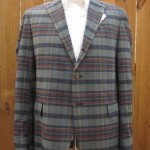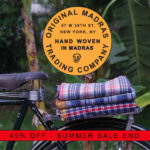
One of the advantages to collecting vintage madras is that it provides the opportunity to compare the idiosyncrasies of this unique fabric. Just as no two bolts of madras are completely alike, no two madras jackets are alike.
As a counterpoint to the in-depth historical analysis of Christopher Sharp and the poignant madras-heyday memoirs of Richard Press, I’d like to showcase a few fine “survivors” (to borrow Mr. Press’ term) from my stock to show precisely what those great old advertisements were on about.
First up is a near-deadstock beauty from Langrock, Princeton’s premier campus shop, circa late 1960s or very early 1970s:

Though is has all the hallmarks of Ivy League tailoring, including ultra-soft shoulders, structurally it is more akin to a normal sack sport coat than other earlier madras jackets, which were tailored in a much more unconstructed manner.
As you can see from the top image, the fabric is virtually unfaded. And while it possesses the irregularities in the weave that are a hallmark of hand-woven madras, the cloth from this era has a much softer, more linen-like hand than earlier examples of the fabric.
Now consider this jacket, which has survived in deadstock condition since the late 1950s. Authentic bleeding madras from The Kent Shop of Denver, Colorado, of all places. Not exactly what comes to mind as a hotbed of warm-weather attire, but it illustrates the widespread popularity of the cloth during its heyday.

The jacket is almost completely unstructured, with zero shoulder padding and minimal lining:

Note the absence of felt behind the collar, which has been attached to the body of the jacket by hand:

What is most striking about this piece, however, is the shoulder, which seems almost Italian in its construction. Though there is absolutely no padding, there is a very subtle roping at the sleeve head and some slight puckering at the sleeve cap that is consistent with Italian spalla camicia construction:

But lest this last detail calls into question the coat’s Ivy League pedigree (very old Brooks Brothers jackets have a similar detail at the sleevehead), let the jacket’s lapped back seam and hooked vent reassure you:

In closing, I will not attempt to surpass Mr. Press’s eloquent call-to-arms for a renaissance of authentic tailored madras. I will say only this: Designers, please take note. — ZACHARY DELUCA










Wonderful colors in that Langrock jacket.
Apparently I was not mistaken in recalling the vibrancy of Madras colors in the 1960s.
Not a pigment of my imagination.
An insightful and informative presentation.
These photos make me sad that I ever got rid of the vintage unstructured Madras jacket that I found in a shop on Carnaby Street in London back in 1989. What was I thinking!
This post was a perfect storm. Great insight from Mr. DeLuca and some beautiful jackets, all taken in while wearing vintage madras trousers purchased from the author himself. Upstanding and gracious merchant!
We have a rather famous guy in Canada who might dress in a jacket like this – although he would not likely wear a “suitable” shirt and tie with it. His name is Don Cherry – google his name and check out the images of him in plaid.
I have a very nice J. Press jacket that I bought in the NY store in the late 90s that is much like the Langrock jacket at the top. I quite like the second jacket, from The Kent Shop of Denver, and wish that more contemporary Madras jackets would lean toward earthier tones. Some Persian carpets are called “tea-washed,” because the cream or white tones are darkened to tan after the weaving is complete (perhaps originally with actual tea). I would love a Madras jacket that mimicked the effect, with tones in olive, tan, burgundy, mustard and navy set off by a “tea-washed” cream. I have a couple of ties that achieve the effect, and would love it in a sport coat.
@Old Soul: 10/10 for “pigment of my imagination.”
@Charlottesville: What a beautiful description, and now you’ve got me googling those rug palettes
@Zach: beautifully written piece
Standard khakis today, with BB OCBD in blue, sack blazer, 763’s, Seamaster on olive strap and an ’80’s vintage Robert Talbot madras belt from college days. Madras is red, tan and brown plaid. No tie or socks today. All this madras talk inspired me to pull it out of storage.
Cheers
Will
Always loved Madras. Bought my first jacket at the old Abercrombie and Fitch in 1959 for $25.00. I’d never seen or heard of the fabric before. Got to Lawrenceville later that fall and found everyone wore them. Years later visited the city itself but don’t remember seeing the fabric then.
Curious; I picked up a 3/2 roll Southwick grey flannel suit with all of the ivy details dating from the same period sold at the same retailer. Made its way all the distance to Calgary, Alberta. Perhaps Denver was more Trad than people might think in the age of moon landings.
Gorgeous blazers. I’m a bit jealous. Had a very similar blazer to the top one back in college, with the same exact colors & pattern. Also had a casual RL “golf jacket”/windbreaker in the same colors & pattern). Outgrew both many years ago, but still have the golf jacket, which I’m keeping around for the sake of nostalgia and maybe someday fitting into once again. (One can dream.)
I’ve searched high and low for a 44L in the same pattern & color scheme, to no avail. Came close while perusing Brooks last summer, but the “Regent” cut of the “44L” was laughable. Most ill-fitting garment I’ve ever tried on. So disappointing. The search continues.